Nicknamed ‘The First State’, Delaware has some seriously bird-friendly geographical highlights scattered throughout the Appalachian Piedmont and the Atlantic Coastal plain. As a result, Delaware birders are in for a treat but it always helps to have an inside scoop on our fine feathered friends. That’s where we come in and today we will discuss the popular backyard birds of Delaware to let you know some of their identifying marks, favorite foods, forest hangouts, and more! Let’s talk about those Delaware birds!
3 Categories – 390 Birds
We weren’t kidding when we said that this is a bird-friendly state, as Delaware is host to somewhere around the neighborhood of 390 different Avian species! That’s a lot of feathers to look for and the first step is going to be knowing ‘when’ to look. To that effect, we’re going to take a sampling of local birds and divide them up like this:
- Year-round Resident birds
- Birds of Spring, Summer, and Early Fall
- Fall and Winter Birds
We’ll follow up with location and identification goodness as well as some feeder-food recommendations and with any luck you might just make some new backyard friends.
Delaware’s Year-round Resident birds
These birds love the First state and can’t get enough of it. As such you can spot them in many different places at any time of the year. See if you can spot one of these local year-round resident birds:
- American Robin
- Red-bellied Woodpecker
- White-throated Sparrow
- Tufted Titmouse
- Carolina Wren
American Robin – Turdus migratorius
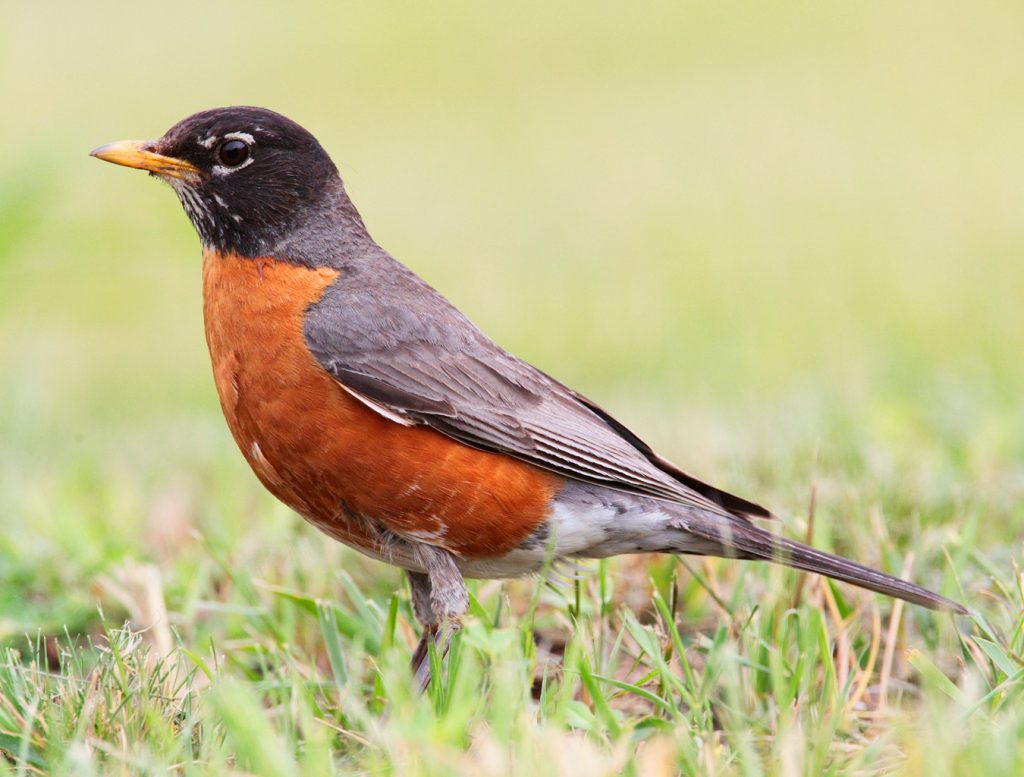
Coloration and Markings: American Robins have dark grayish-brown backs as well as long wings and long tails of the same color. You will see some white edging in the side and underside of the tail and this is coming from the Robin’s white rump. The underbelly and breast of this bird are a tangerine orange color and facially, these birds have black heads with visible eyerings, although the eyerings look as if they have been dropped and shattered into pieces. These birds have medium length, slightly curved yellow bills.
Size: These birds measure in at 7.9 -11 inches in length and have wingspans of 12.2 to 15.8 inches wide.
Habitat: Robins may be found in a number of areas, preferring deciduous woods and pine forests but also commonly found in tundra, fields, parks, and pastures. They happily visit backyards as well if there is a well-stocked feeder present.
Diet: Suet, crushed peanuts, and chopped apples are all favorites that you can leave out to potentially lure in a Robin for a closer look.
Red-bellied Woodpecker – Melanerpes carolinus

Coloration and Markings: Red-bellied Woodpeckers look quite exotic, with zebra striping on their backs, long wings and shorty, stocky tails. The underbelly and breast of this bird will be white with the exception of multiple splashes or red color, especially on the belly where you can see a distinct red spot. These birds have white faces, with a splash of red at the cheeks, and a long, red cap that goes down to the nape of the neck. These birds have long, straight, and thick black bills.
Size: These birds measure approximately 9.4 inches from head to tail and have wingspans of 13 to 16.5 inches in width.
Habitat: These birds love the woods and are especially fond of oaks, pine, maple, and hickory trees. They range out quite often, however, visiting backyards and the feeders which they find there.
Diet: These birds love suet, grape jelly, and even shelled peanuts, so be sure to leave one or more of these items out in your feeders if you’d care to tempt the Red-bellied Woodpecker to come in for a backyard visit.
White-throated Sparrow – Zonotrichia albicollis
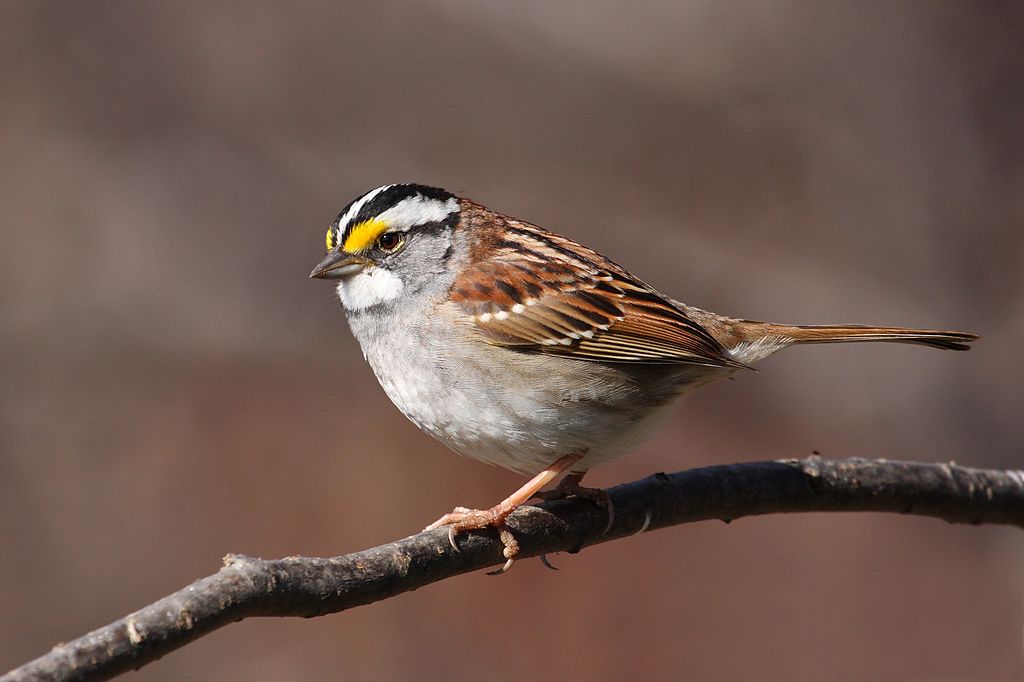
Coloration and Markings: White-throated Sparrows have brown backs with medium-length brown wings, sporting 2 very thin wingbar markings you might see if you look closely, and they have long, brown tails. The underbelly and breast of this bird are white with a heavy flanking of brown on the sides and towards the top of the breast there is a v-shape of gray color coming down from the face like a long, gray beard. Most of this bird’s face is gray but it also has a white chin, as well as a large, white eyebrow line with a spot of yellow close at the front, next to the bill. Above this is a ‘skunk cap’ consisting of a black stripe on each side of the head and a white, central stripe down the top and middle. One variety, known as ‘Tan stripe’ will have brown and tan instead of black and white and these birds have medium-length, conical silver bills.
Size: These birds measure in at 6.3 – 7.1 inches in length and have wingspans of 7.9 to 9.1 inches wide.
Habitat: These Sparrows may be found deep in the woods but they are also fond of open areas, especially near water. Check for them at the forest’s edge, open areas of woods close to a bog or a pond, or in the winter you can look for them anywhere there is a little dense brush cover. These birds to happy to visit well-stocked backyard feeders so be sure to leave a little something out that they like.
Diet: White Proso millet and Black Oil Sunflower seeds are both favorites of the White-throated Sparrow. Be sure to sprinkle a little seed around the base of the feeder to get their attention and use a ground feeder for best results.
Tufted Titmouse – Baeolophus bicolor
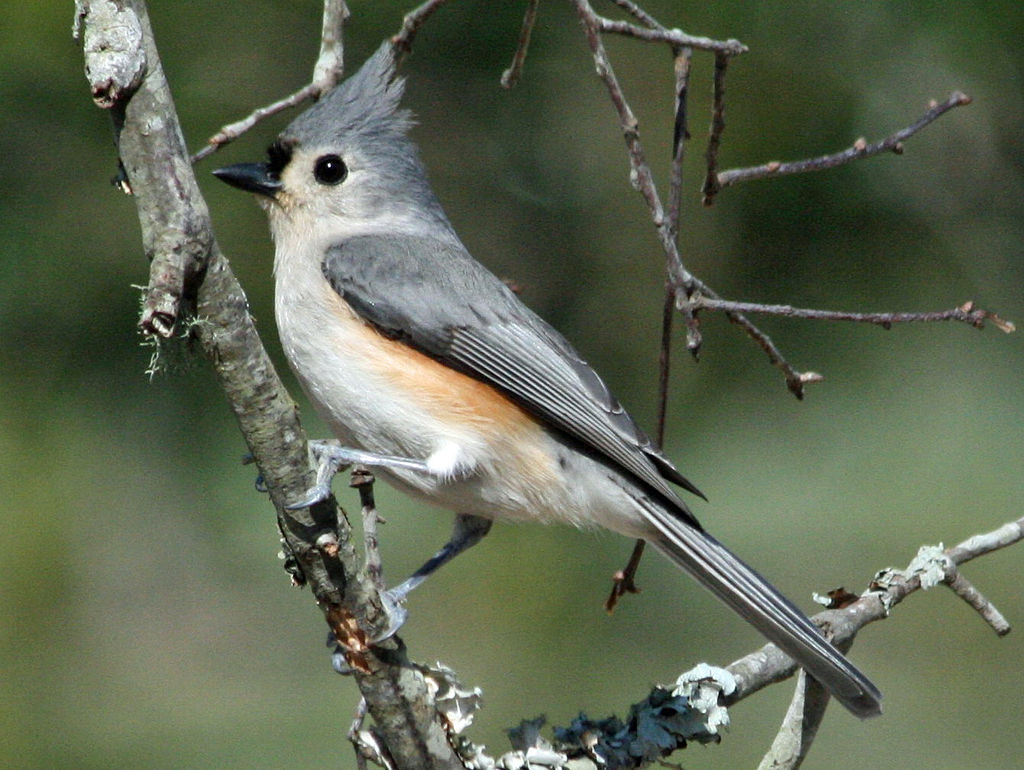
Coloration and Markings: The Tufted Titmouse have a soft bluish-gray back with short wings and a long tail, both of the same silvery-blue color. They have whitish coloration on the underside of the tailfeathers and the underbelly and breast of this bird will be white with a gentle peach coloration present underneath the wings. Facially, these birds have a small, soft blue crest, and some of the color goes down the back of the neck and frames the back of the eyes, though the remainder of the face is mostly white. A big, distinct exception is a large, black spot just above the bird’s small (but stout) triangular black bill.
Size: These birds measure in at 5.5 – 6.3 inches from head to tail and have wingspans of 7.9 to 10.2 inches.
Habitat: These birds are especially common in evergreen and deciduous woods at lower elevations. They range out often and you can find them in places like orchards, parks, and backyards with stocked-up feeders.
Diet: Suet, peanuts, and hulled Black Oil Sunflower seeds are 3 favorites of Tufted Titmice so be sure to leave one or more out and you might just make a new friend.
Carolina Wren – Thryothorus ludovicianus

Coloration and Markings: Carolina Wrens have foxy-brown backs, with small wings and long, perky tails, which display a bit of ‘checkerboarding’ in the form small, black and white spots on the edges of the wings and the tail. The underbelly and breast of this bird are a tan-orange mix and facially, the lower half of this bird’s face is white with a little gray at the cheeks and a thick, brown eyeline under a white eyebrow line, with a brown crown above which goes all the way back. These birds have long, slightly-curved dark colored bills.
Size: These plump little birds measure in at a mere 4.7 – 5.5 inches in length and have wingspans averaging 11.4 inches in width.
Habitat: These birds love the woods and hang out where the vegetation is dense, so if there are brambles, thickets, and thorns nearby then you might just spot a Carolina Wren.
Diet: Suet and Black Oil Sunflower seeds will work any time of the year with this bird but when it gets colder, try adding some fresh berries into the mix. These little Wrens will love you for it.
Delaware’s Birds of Spring, Summer, and Early Fall
Tulips are blooming and groundhog tracks are present (even skunk tracks if you know what you are looking for!). It is official, spring has arrived in Delaware! During the next few months a lot of birds will be making an entrance and typically sticking around until early fall. See if you can spot one of these birds in the warmer months:
- Indigo Bunting
- Eastern Kingbird
- Brown-headed Nuthatch
- Scarlet Tanager
- Orchard Oriole
Indigo Bunting – Passerina cyanea

Coloration and Markings: Male Indigo Buntings have lovely plumage, being completely a light indigo blue all over. They have short wings which makes their short, rounded tails look a little longer, and you might see a little gray in their plumage when they are molting. Female Buntings tend to be an olive-brown color, with heavy streaking at the underbelly and breast and they have some blue spots around the wings, rump, or tail and juvenile males will be a heavily blue-patched olive-brown color. These birds have medium-length, stout, conical silver bills.
Size: These little birds measure in at 4.7 – 5.1 inches in length and have a wingspan of 7.5 to 8.7 inches wide.
Habitat: Indigo Buntings love brush cover, so look for them in overgrown fields, bushes, and when not foraging, singing from lofty branches.
Diet: Nyjer thistle and White Proso millet are two favorites of this bird that you can mix or present separately to tempt them to your feeder.
Eastern Kingbird – Tyrannus tyrannus
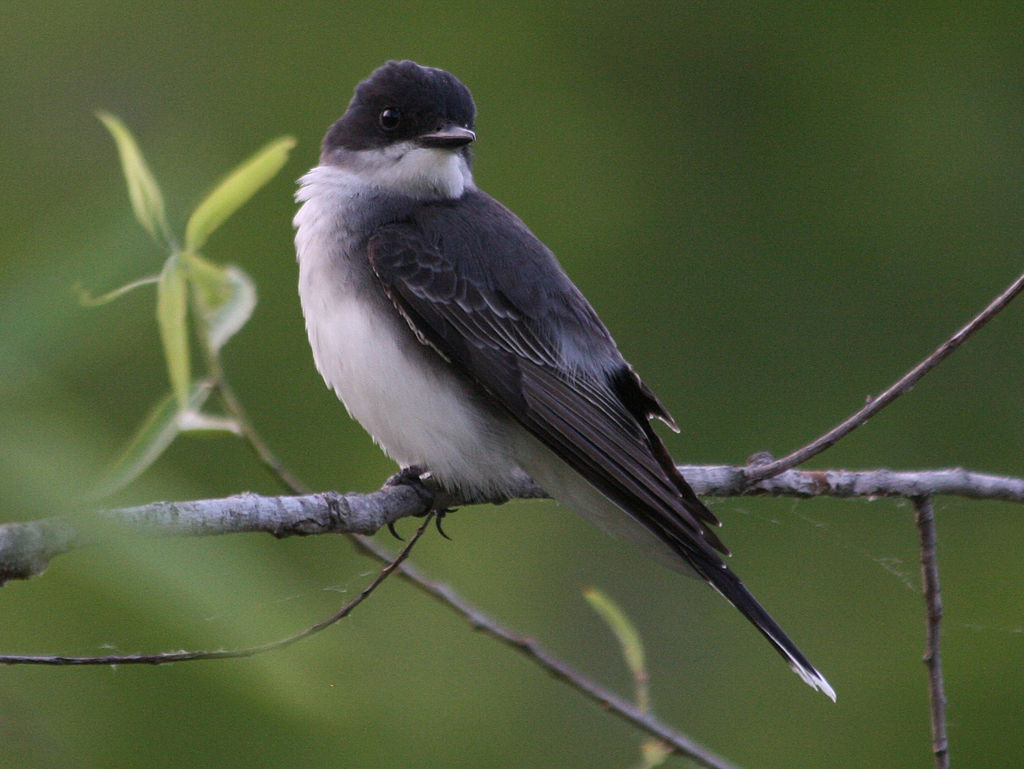
Coloration and Markings: Eastern Kingbirds have dark gray to black backs with long wings, which exhibit some minute white edging, and long, square-tipped tails which are white at the tips. The underbelly and breast of this bird are paper-white as well and this carries up into the face, with white on the chin and framing the cheeks from underneath. The upper portions of the face will be dark gray or black and these birds have straight, thick, and medium-length bills.
Size: Roughly Robin-sized, these birds measure in at 7.5 – 9.1 inches from head to tail and have wingspans of 13 to 15 inches wide.
Habitat: Kingbirds like open areas, so look for them in fields, pastures, and especially in wetlands as this bird prefers to be close to water.
Diet: Eastern Kingbirds love to winter in South America, where they eat lots and lots of fruits. Try leaving out some halved oranges or chopped cherries and you might just get these bird’s attentions.
Brown-headed Nuthatch – Sitta pusilla

Coloration and Markings: Brown-headed Nuthatches have gray backs with small, gray wings which are often brown around the edges and short, stubby tails which are mixed browns and grays. The underbelly and breast of this bird are a mix of white and grays and facially, this bird has a paper-white chin, cheeks, and throat while the rest of the head is light and dark brown. These birds have long, straight, and pointy black bills. Sometimes white spots may be visible on the tail or the back of the head but they are easy to miss in a bird this size.
Size: These tiny acrobats measure only 3.9 – 4.3 inches in length and have wingspans of 6.3 to 7.1 inches wide.
Habitat: These birds love pine forests, either dense or open, and you can also find them in woods where hardwoods and pines copses and stands.
Diet: Suet and crunchy peanut butter are almost irresistible to Brown-headed Nuthatches. Try adding them into your feeders and see what happens when this bird takes notice!
Scarlet Tanager – Piranga olivacea
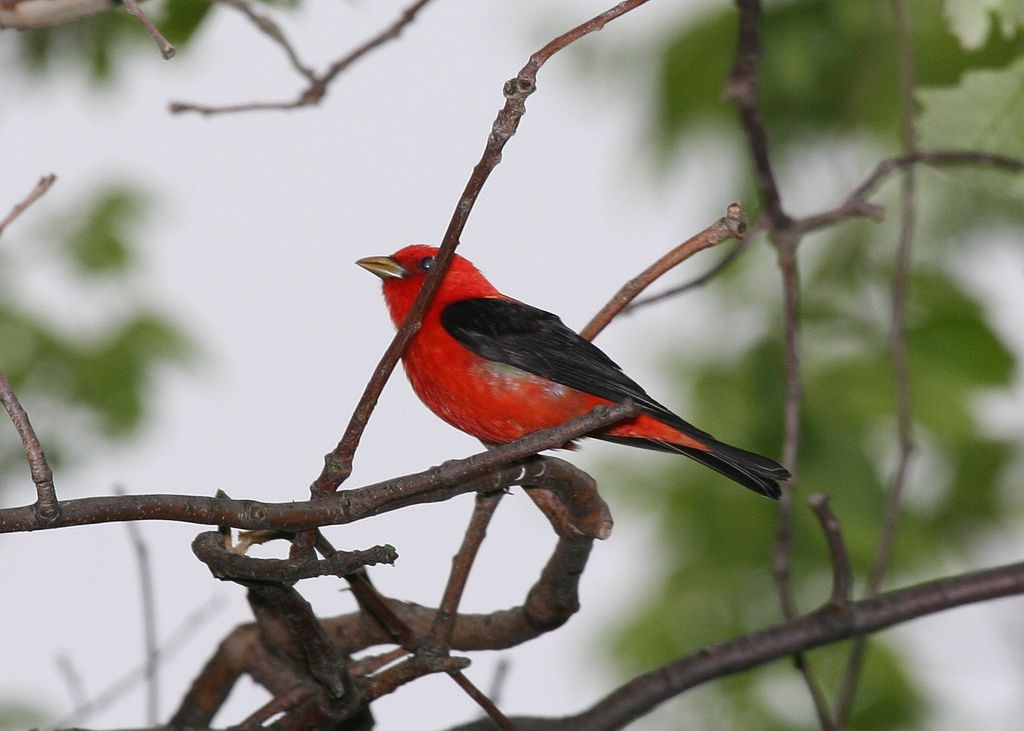
Coloration and Markings: Male Scarlet Tanagers have bold red backs with small, black wings which sometimes show tiny spots of yellow or red around the shoulders when they are not completely black. They have short, forked tails and their underbelly and breast are completely red (sometimes flame orange spots may be visible as well.). Facially, the scarlet color is at its most intense and this bird has a thick off-yellow or yellow and black bill. Females and Juveniles will have an olive-yellow and olive coloration on their wings and bodies and Males will adopt this color after mating season, though they will retain their black wings.
Size: These birds measure in at 6.3 – 6.7 inches in length and have wingspans of 9.8 to 11.4 inches in width.
Habitat: These birds prefer deciduous forests or regions of woods where there is a deciduous evergreen mix. They do visit the occasional backyard, especially during migration periods, so be sure to leave a little something out for these little red wonders.
Diet: Halved oranges, suet, and even grape jelly can be used to tempt the Scarlet Tanager into your backyard for a closer look.
Orchard Oriole – Icterus spurius

Coloration and Markings: Orchard Orioles have black backs with medium-length black wings which have white edging towards the tips as well as a a reddish-brown patch at the shoulder and a pan-flute style series of vertical lines towards the wing center. They have medium-length notched tails and the underbelly and breast of this brd are a chestnut or foxy brown color, with some black coming down in a v-shape at the breast from the bird’s completely black head. This bird has a straight, sharp, rounded bill and females will look a bit different. Lacking the black of the male, females display yellow-green plumage with 2 white wingbars on each wing. Juveniles have the same coloration as females with the exception of black around the throat as well as the bill.
Size: These birds measure in at 5.9 – 7.1 inches from tip to tail and have wingspans of approximately 9.8 inches wide.
Habitat: These birds love the open woods, especially areas close to water. You can also find them in pastures, orchards, parks, and the occasional backyard.
Diet: Fruit and berries are an easy way to tempt this bird. Try leaving out some chopped apples, cherries, or halved oranges to get the Orchard Oriole’s attentions.
Delaware’s Fall and Winter Birds
Delaware winters are chilly, reaching average lows of 25 degrees, and while you and I might grumble there are some brave, feathered friends of ours out there who aren’t bothered in the slightest. Show your support with some nutritious feeder-offerings and you might get a few visits from one or more of these birds:
- European Starling
- Dark-eyed Junco
- Northern Mockingbird
- Evening Grosbeak
- Purple Finch
European Starling – Sturnus vulgaris
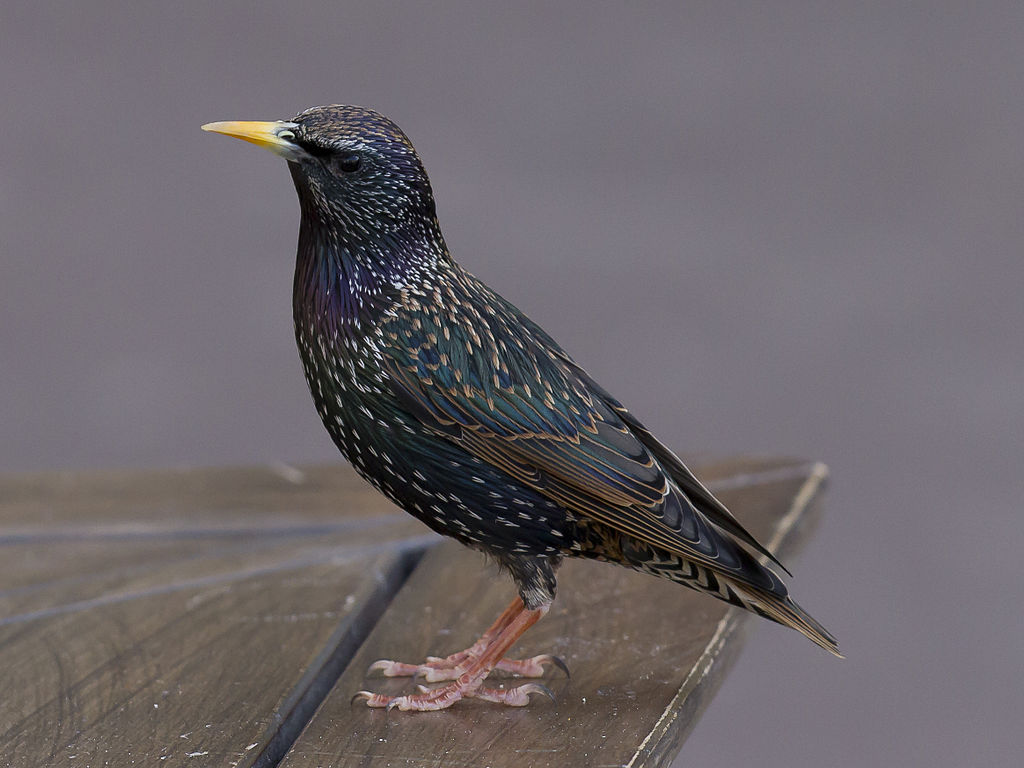
Coloration and Markings: European Starlings are easy to mistake for Blackbirds at first, but a closer look reveals that the black plumage all over their bodies is composed of a mix of purples and greens. They have medium-length wings and short tails, giving the impression a ‘star’ shape when they fly, and in the winter these birds exchange the purple-green for a brown coat of plumage with lovely white spots. These birds have long, thick, and straight yellow bills.
Size: Starlings measure in at 7.9 – 9.1 inches in length and have wingspans of 12.2 to 15.8 inches wide.
Habitat: These birds love to be near people, so look for them close to farms or right in the middle of the city, where you can spot them on fences and phone lines while they scout the area for good foraging.
Diet: European Starlings love suet, perhaps a little too much. Consider a Starling-proof feeder if they are eating all of the suet cakes and you can still keep them happy with wheat, rolled oats, and dried or fresh berries that you might have on hand.
Dark-eyed Junco – Junco hyemalis

Coloration and Markings: Dark-eyed Juncos have a lot of regional variety when it comes to their plumage, though the ‘default’ configuration for this bird is a dark brown or gray back with medium-length wings and a long tail of the same color. The undersides of the tail will be white, however, as is the bird’s rump, underbelly, and breast, though starting at the underbelly this bird has a heavy flanking of dark brown or gray that increases in density as it moves to the breast. Facially, these birds have dark brown or gray faces and a stout, medium length, conical pink bill.
Size: Juncos measure in at 5.5 – 6.3 inches in length and have wingspans of 7.1 to 9.8 inches wide.
Habitat: These birds like coniferous woods but they will settle for mixed coniferous if they need to. They roam quite a bit when they are not in the woods, so you can also find them in overgrown fields, parks, and the occasional backyard as well.
Diet: Hulled Black Oil Sunflower seeds, White Proso millet, and cracked corn are 3 foods that you can potentially attract the Dark-eyed Junco to your feeder with. They are ground foragers, so be sure to use a ground feeder and sprinkle some seed around the base of the feeder for best results.
Northern Mockingbird – Mimus polyglottos

Coloration and Markings: Northern Mockingbirds have grayish-brown backs with short, broad gray wings and long, perky gray tails. The wings will exhibit large, white patches when the bird is in flight and when at rest you can see 2 white wingbars on each wing. The rump, underbelly, and breast of this bird are white and facially, this bird is mostly a soft gray with some white around the cheeks, chin, and throat as well as a gray eyeline that curves down and around the cheek and connects with a gray mustache line. These are hard to see but you can spot them on some birds if you look closely. These birds have long, black bills which exhibit a slight downward curve.
Size: These birds measure in at 8.3 – 10.2 inches from tip to tail and have wingspans of 12.2 to 13.8 inches wide.
Habitat: When they aren’t spending time at the forest’s edge, these are town and city birds, so look for them the next time that you are out and about and you might spot one. They are happy to visit a well-stocked feeder, too, so leave something out to let them know that you are thinking of them.
Diet: Mockingbirds like suet but they’ll also be happy if you have chopped apples or orange halves in the feeder.
Evening Grosbeak – Coccothraustes vespertinus
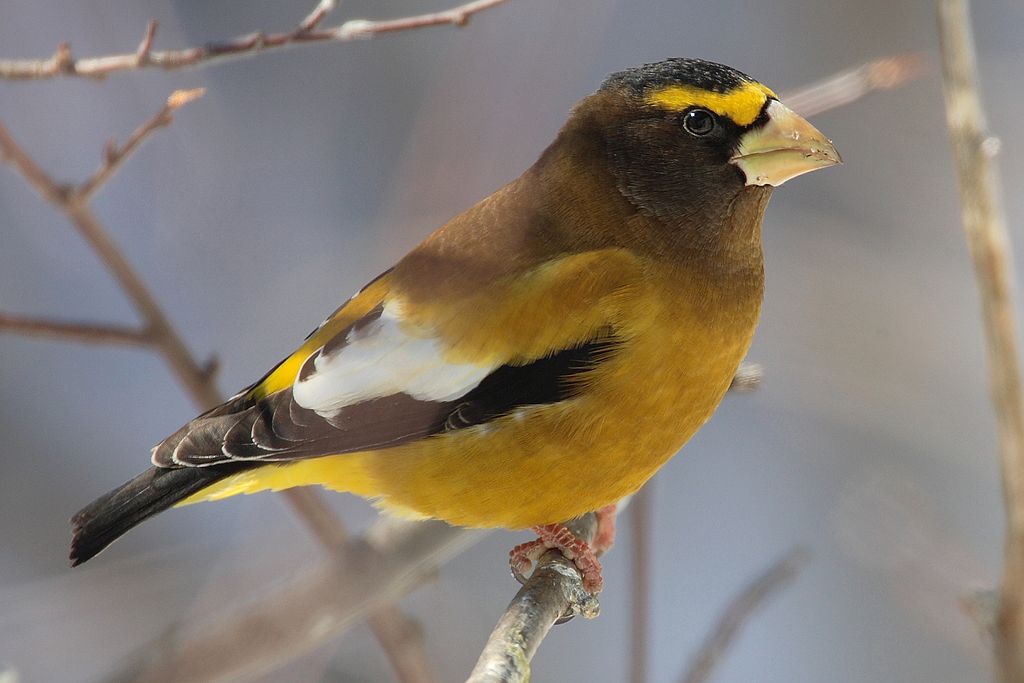
Coloration and Markings: Adult Evening Grosbeak males have olive-brown backs, with long, black wings which are yellow at the shoulder and have a large white patch. They have short, forked black tails and the underbelly and breast of this bird are yellow in color and some brown v’s into the breast from the throat. These birds have thick necks and facially, they have brown faces with a large, yellow eyebrow stripe and a small, black cap. These birds have large, medium length bills which are pale white on males and yellowish-green for females. Female and juvenile plumage will be mostly gray, with some yellowish green on the back of the neck as well as some on the lower body and both genders will have the distinctive black and white wings.
Size: These birds measure 6.3 – 7.1 inches in overall length and have wingspans of 11.8 to 14.2 inches wide.
Habitat: These birds are a little unpredictable. While they love to spend time in deciduous or coniferous and deciduous mixed forests they also range in seemingly random patterns. So, keep an eye out, because these birds can pop up in your backyard at the oddest times.
Diet: Suet and Black Oil Sunflower seeds are all that you need to attract these beautiful birds. Be sure to stock up and you might just make a new feathered friend.
Purple Finch – Haemorhous purpureus
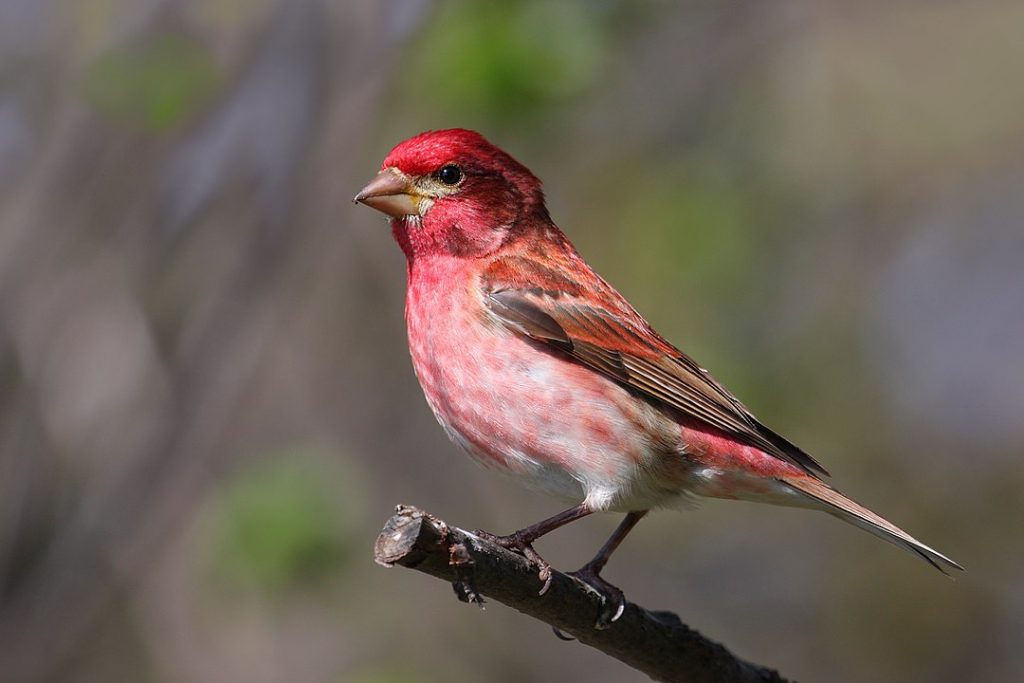
Coloration and Markings: Male Purple Finches look like brown Finches that have fallen into a juice cup. They have brown and reddish purple backs, medium-length wings with 2 thin, white wingbars, and short, notched tails. The underbelly of this bird is white with raspberry streaks but the breast is saturated in dots of raspberry coloration. Facially, these birds have reddish-pink faces with darker raspberry eyestripes which pass the eyes and curl down and around the cheek and a darker raspberry cap starting from the middle of the head to the nape of the neck. These birds have thick, conical, black and yellow bills. Female Purple Finches will have no purple at all, but are olive colored and have olive streaked light breast and underbelly and white eyestripes as well as a thick, white mustache line.
Size: These birds measure in at 4.7 – 6.3 inches in overall length and have wingspans of 8.7 to 10.2 inches wide.
Habitat: These birds prefer coniferous and coniferous/deciduous mixed woods, but they range out quite often in the winter. During this time you can spot them in overgrown fields, parks, and backyards or simply playing at the forest’s edge!
Diet: Safflower seeds, Nyjer thistle, and cracked corn are all favorites of the Purple Finch.
Supporting cast (Other Backyard Birds of Delaware that might pay you a visit)
While they don’t get the fancy front-page’ coverage, our ‘Supporting cast’ is a bird roster of winged celebrities that are there for you at any time of the year and just as lovely as our front-page birds. See if you can spot one of these ‘Supporting cast’ birds this year:
- Mourning Dove
- Northern Cardinal
- American Goldfinch
- House Finch
- Gray Catbird
Mourning Dove – Zenaida macroura
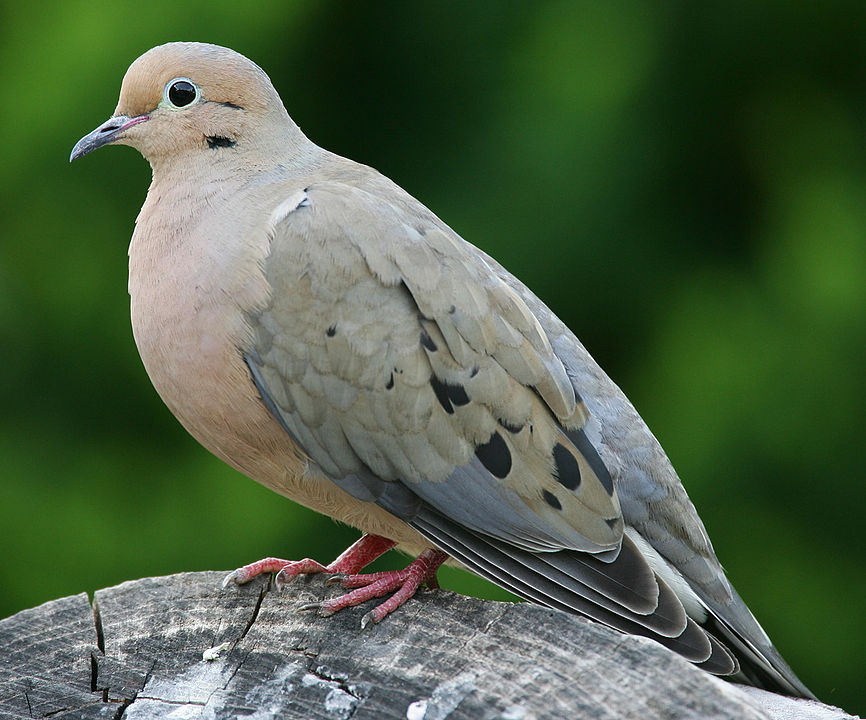
Coloration and Markings: Mourning Doves have gray backs with large, gray wings which have distinctive black dots and heavy tan coloration towards their centers. They have long, pointed tails, and the underbelly and breast of this bird are a creamy tan color. Facially, we have even more tan coloration and you will also notice a lovely white eyering. These birds have medium-length, thin, black bills.
Size: These birds measure in at 9.1 – 13.4 inches in length and have wingspans of approximately 17.7 inches wide.
Habitat: The Doves don’t like the woods, preferring large stretches of bare ground or patchy, weedy fields. They are quite comfortable in the city as well and you can see them on the sidewalk or fences as they scope out the area in search of snacks.
Diet: Cracked corn and White Proso millet are two favorites of these Doves that are easy to provide and might just keep them coming back for more.
Northern Cardinal – Cardinalis cardinalis
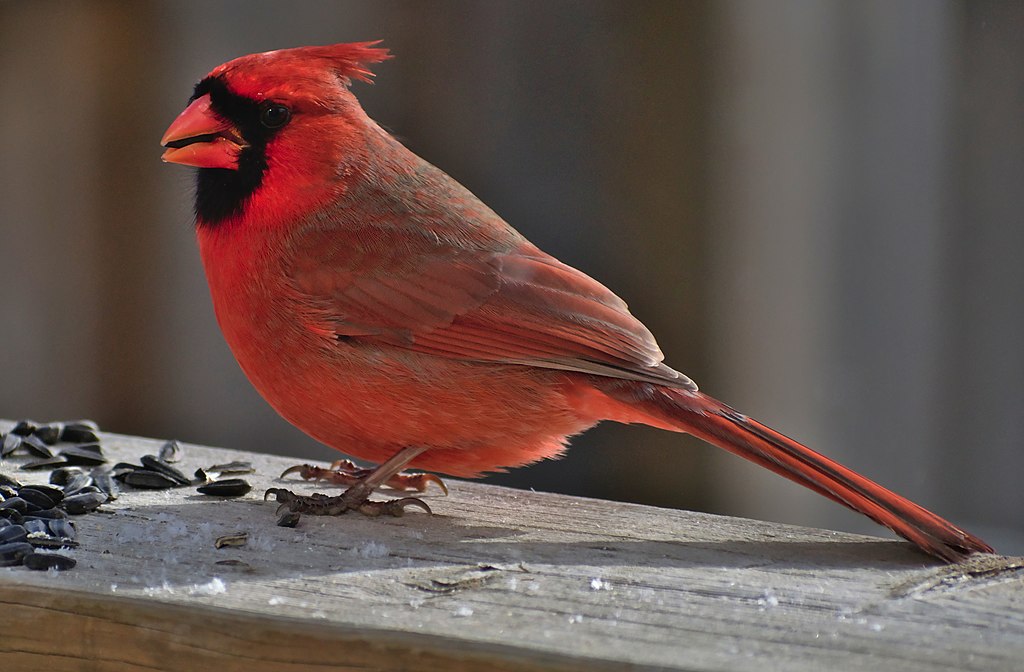
Coloration and Markings: Male Northern Cardinals are one of the easiest birds to identify, with their majestic, red crests and almost completely red plumage. They have medium-length wings and long, red tails and facially you will also notice the distinctive black mask that carries down from the eyes to make a pointed appearance on the chin. Female Cardinals, by contrast, are a soft brown color overall with some reddish splashes of color throughout the plumage. These birds have stout, medium-length, and conical reddish-orange bills.
Size: These birds measure in at 8.3 – 9.1 inches in length and have wingspans of 9.8 to 12.2 inches wide.
Habitat: When they aren’t at the forest’s edge, Cardinals may be found in woodlots, parks, and backyards with well-stocked feeders.
Diet: Cracked corn, Nyjer thistle, and peanuts can attract and keep the attentions of the lovely Northern Cardinal.
American Goldfinch – Spinus tristis

Coloration and Markings: The male American Goldfinch has a bright yellow back with long, black wings and a short, black tail. The wings will have 2 white wingbars each as well as some assorted vertical markings towards the center which are repeated on the tail. The underbelly and breast of this bird are bright yellow like the back and facially, this bird is yellow except for a small black cap at the forehead and a medium length, conical orange bill. Females will have less vibrant yellows and olive coloration instead of the black and in winter, both genders assume an unremarkable brown plumage, though there will still be dim wingbars present.
Size: These diminutive birds measure in at 4.3 – 5.1 inches in length and have wingspans of 7.5 to 8.7 inches wide.
Habitat: Goldfinches love overgrown fields, especially those which are prone to flooding and therefore an excellent place to forage in relative cover. They get around quite a bit, however, so you can see them at roadsides, orchards, gardens, and backyards.
Diet: Suet mixed with peanut butter is a secret weapon in your arsenal for attracting birds like the American Goldfinch. Give it a try sometime and see for yourself, these little guys and gals seem to love it!
House Finch – Haemorhous mexicanus
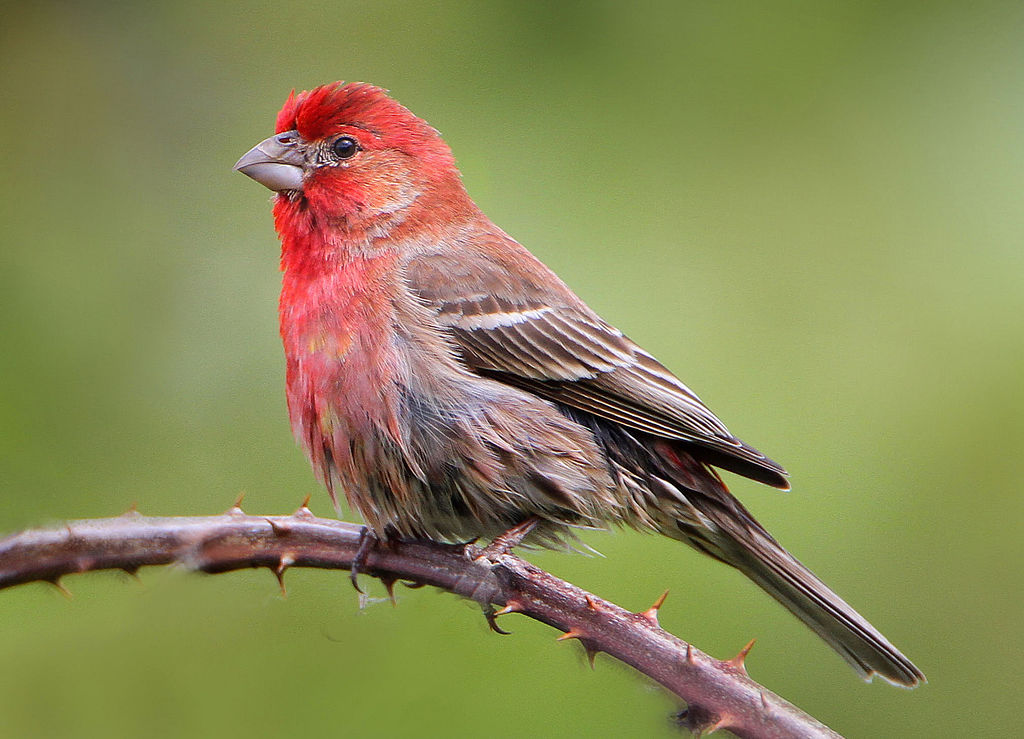
Coloration and Markings: House Finches have streaky brown or gray backs with short, vertically streaked wings displaying 2 thin, white wingbars on each wing and long gray or grayish brown tails with white on the outside edges close to the rump. These birds have a white, dark streaked underbelly and the breast of this bird will show some streaking as well as a heavy saturation of pinkish red that carries up into the face. These birds have mostly pinkish-red faces, with gray at the base of the throat and the back of the neck and a gray eyeline that curves around to frame the cheek. Females lack the red color and will be grayish brown overall, with thick, blurred streaking at the underbelly and breast. These birds have stout gray bills with a curve on the upper bill present.
Size: These Finches measure in at 5.1 – 5.5 inches in length and have wingspans of 7.9 to 9.8 inches.
Habitat: These birds spend a lot of time at the forest’s edge, but you can also spot them at farms, parks, and even in brushy desert areas. They will happily visit a backyard feeder if you leave a little something out for them.
Diet: Hulled Black Oil seeds and Nyjer thistle are an easy offering that can make House Finches very happy.
Gray Catbird – Dumetella carolinensis

Coloration and Markings: Gray Catbirds have stone-gray backs, as well as broad, rounded, and medium length wings of the same color. They have long, gray tails and underneath close to the rump you will see a patch of foxy-brown coloration. The underbelly and breast of this bird are stone-gray, as is the face, and this bird has a small black cap as well as a long, thin, straight black bill.
Size: Roughly Robin-sized, these birds measure in at 8.3 – 9.4 inches in length and have wingspans of 8.7 to 11.8 inches in width.
Habitat: Catbirds love thickets, brambles, shrubs, and thorns… Especially if there is water nearby. You can also spot them in overgrown fields from time to time or the forest’s edge.
Diet: Suet and Sunflower hearts are a great way to get a Gray Catbird to visit your backyard feeder so that you can get a closer look!
Delaware Winter Bird Buffet
Today we’re going to share a little of our own advice as well as some from Delaware online in their article entitled “Winter feeding leads to great bird watching”. We’ve got a link to the article in our references if you would like to read it in full but today we’ll just share a few highlights and suggestions of our own to help you to make that perfect winter feeder:
- Suet
- Black Oil Sunflower
- Crunchy peanut butter mixed with suet
- Cracked corn, millet, and milo sprinkled at the base of the feeder are cheap feeds and can get attention.
Delaware Birding Hot spots
If you want to get out there in the wild to see our feathered favorites in action like a real Chirparazzo then we have some great places for you to look. We’ve got spots corresponding with compass points throughout the state but if you don’t find any place that you like, just check our reference links below for more locations. Try to visit one of the following hotspots on your net day off:
- Northern hotspot – New Castle Battery Park Trail
- Eastern hotspot – Georgetown-Lewes Trail
- Southern hotspot – Bob Trail
- Western hotspot – Michael Castle Trail
- Central hotspot – Killens Pond Bike Trail
Detailed descriptions of each location as well as information regarding visiting and what birds you can see at these locations may be found at https://www.traillink.com/stateactivity/de-birding-trails/
In Closing
Today we have talked about the popular backyard birds of Delaware and we hope that you will put some of these tips to the test. Delaware is a great place for birding so you’ve certainly got a big job ahead of you. Just be sure to practice patience and let those lovely birds do the rest!
